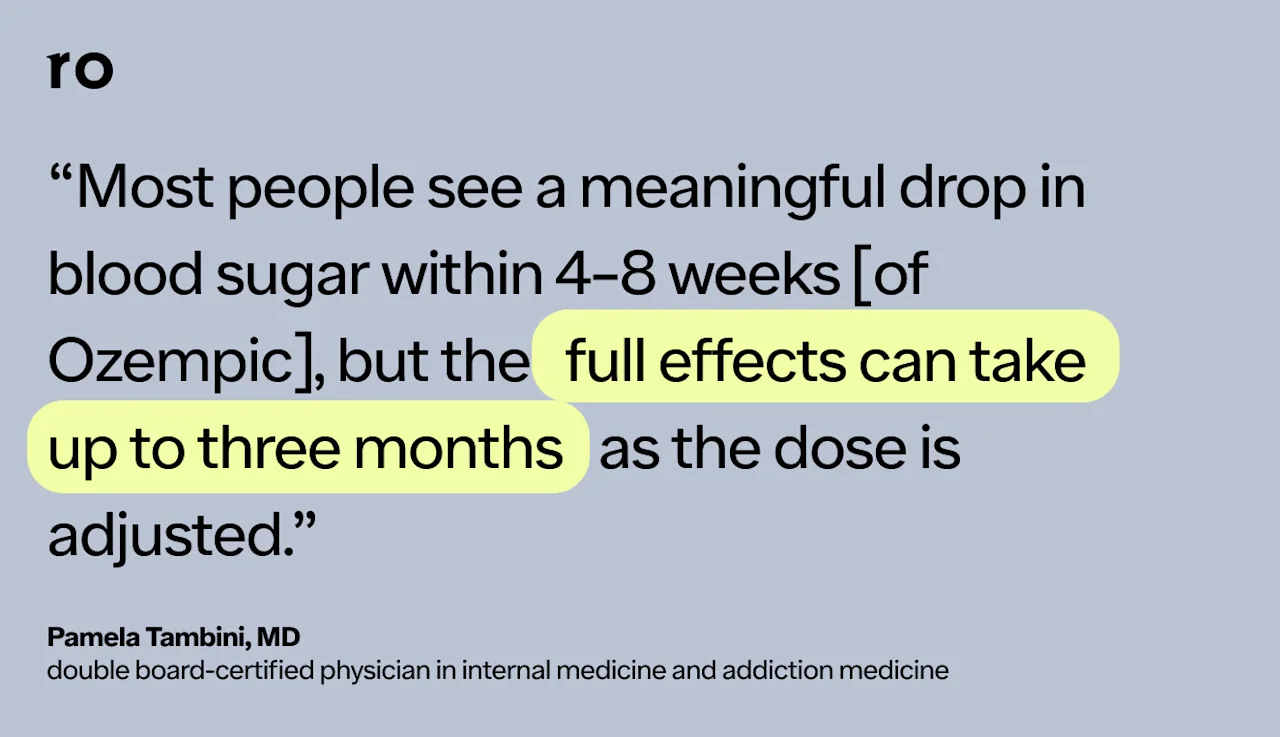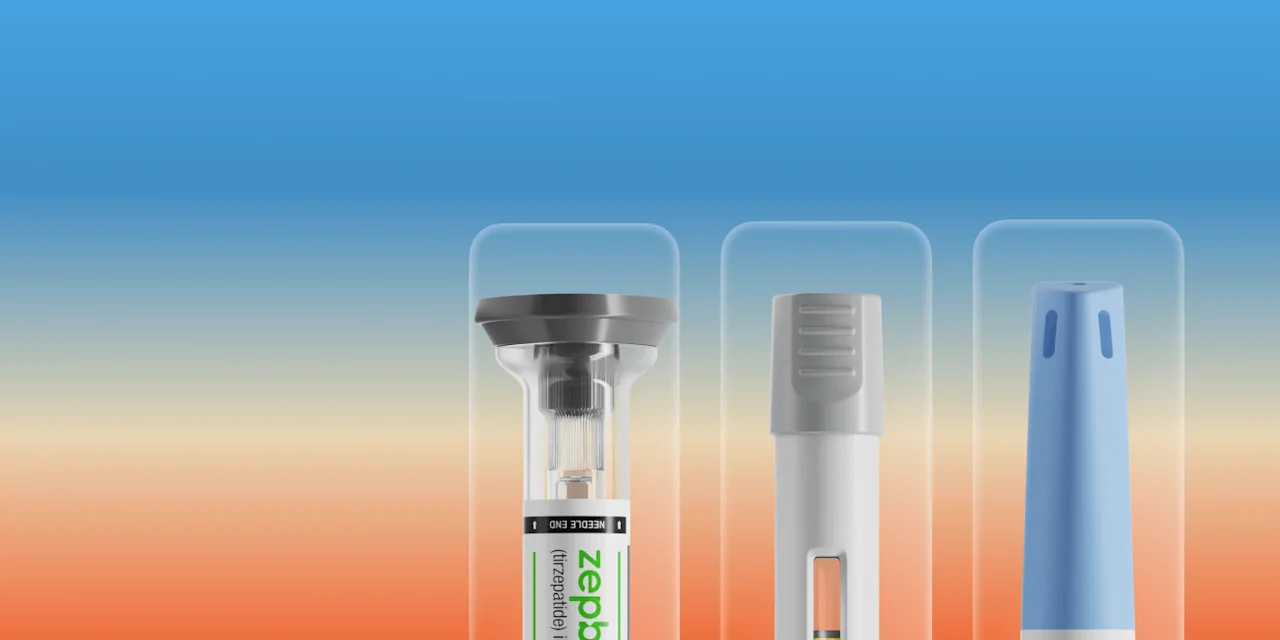Key takeaways
Ozempic can begin working from your first dose (i.e. once you take it), but it can take a few weeks to months to notice the drug’s effects on blood sugar, appetite, and weight.
Most people typically see a reduction in blood sugar levels within the first three months of using Ozempic.
Weight loss on Ozempic may start in the first month, but results tend to be more noticeable after three months of treatment.
Gastrointestinal side effects are common when you start taking Ozempic, with nausea being the most common symptom, followed by diarrhea and vomiting.
Here's what we'll cover
Here's what we'll cover
Here's what we'll cover
Key takeaways
Ozempic can begin working from your first dose (i.e. once you take it), but it can take a few weeks to months to notice the drug’s effects on blood sugar, appetite, and weight.
Most people typically see a reduction in blood sugar levels within the first three months of using Ozempic.
Weight loss on Ozempic may start in the first month, but results tend to be more noticeable after three months of treatment.
Gastrointestinal side effects are common when you start taking Ozempic, with nausea being the most common symptom, followed by diarrhea and vomiting.
Ozempic (semaglutide) is an injectable medication approved by the US Food and Drug Administration (FDA) that lowers blood sugar, body weight, and the risk of death from heart or kidney disease. If you’ve recently started taking Ozempic, you’re probably wondering when you’ll start to see the results of this medication. So, how quickly does Ozempic work? We reviewed the research and talked to experts to find out.
How quickly does Ozempic work?
While Ozempic starts working soon after you start taking it, it takes about 4–5 weeks to achieve a steady level of Ozempic in your system. And because of this, it usually takes some time before you notice any reductions in your blood sugar levels or appetite and weight loss, says Pamela Tambini, MD, a physician double board-certified in internal medicine and addiction medicine.
“Several factors influence how quickly [Ozempic] works, including the dose, individual metabolism, diet, and lifestyle,” Dr. Tambini says. “A person’s baseline insulin resistance, activity level, and overall health also affect how fast they see changes.”
Ozempic follows a dosage titration schedule. Typically, you start at a low dose of 0.25 mg weekly and gradually increase to a maintenance dose of 0.5 mg, 1 mg, or 2 mg over the course of 9–13 weeks. While this gradual ramp-up schedule is intended to keep side effects manageable at the beginning of your treatment, it also means it can take longer for you to notice any effects of the medication, Dr. Tambini explains.
The dosage you take for the first four weeks is only intended to be a starting dose that helps your body get used to Ozempic and its side effects. It can take up to three months to reach the fully therapeutic maintenance dosage, depending on your body’s response to the medication.
For example, the 0.5 mg dose may adequately control some people’s blood sugar levels, in which case they can stay at that dosage. For others, it may take a higher dose of 1 mg or 2 mg for Ozempic to adequately lower their blood glucose levels. In that case, it may take several more weeks before they notice the blood sugar-lowering effects of the medication.
Having said that, people can usually tell within the first one or two months if their body is responding to Ozempic, says Heather L. Hinshelwood, MD, chief of medicine at The Fraum Center for Restorative Health in Hilton Head, South Carolina. But it’s important to also make the recommended lifestyle changes (e.g. regular exercise, healthy diet) to see the effects of Ozempic.
“GLP1s aren't a panacea,” Dr. Hinshelwood says. “You can't take them, continue not to exercise, continue to eat an unhealthy diet, and still expect to lose weight or see other metabolic results. It's a tool to optimize metabolism while we make positive lifestyle changes.”
How long does it take Ozempic to lower blood sugar?
In short, it can take 1–3 months of taking Ozempic before you see a meaningful drop in your blood sugar levels.
Ozempic mimics a gut hormone called glucagon-like peptide-1 (GLP-1) that encourages the release of insulin after you eat to help keep blood sugar levels in check.
“Ozempic starts working in the body shortly after the first dose, but noticeable improvements in blood sugar levels usually take a few weeks,” Dr. Tambini says. “Most people see a meaningful drop in blood sugar within 4–8 weeks, but the full effects can take up to three months as the dose is adjusted.”
It’s worth noting that HbA1C tests measure your average blood sugar levels over the last 2–3 months. So, it can take at least that long to see the effects of Ozempic reflected in your test results.
“Ozempic stays active in the body for a long time, steadily improving insulin sensitivity and reducing blood sugar spikes,” Dr. Tambini says.
Research reflects how Ozempic continues improving blood sugar levels over time. In one clinical trial, people taking Ozempic for type 2 diabetes experienced an average drop of 1.7% in their HbA1c levels over a 30-week period (about seven and a half months). In a 40-week trial, the average drop in HbA1c levels was 2.1% for those taking 2 mg of Ozempic and 1.9% for those taking 1 mg.

How long does it take Ozempic to work for weight loss?
While it takes time for the full effects of the drug to build, people usually lose a few pounds in the first month of taking Ozempic.
GLP-1 agonists like Ozempic work for weight loss by slowing down digestion, so you feel full sooner. They also interact with the parts of your brain that regulate your appetite and food cravings.
In a 12-week clinical trial of people with obesity, participants taking Ozempic lost an average of 11 pounds in three months. In the aforementioned 40-week study (around 10 months) of people with type 2 diabetes, participants lost 13-15 pounds, with those taking a higher dosage losing more weight. (Research shows that people with type 2 diabetes tend to lose less weight on Ozempic than those without.)
“Some people may notice a difference within the first few weeks, but significant weight loss takes a few months for most,” Dr. Tambini says. Indeed, in the above-mentioned 12-week study, participants lost about 2 pounds in the first four weeks of taking Ozempic. By the third month, however, they had lost over five times that amount.
Dr. Tambini says that weight loss continues over time as a person stays on the medication. “However, weight loss is not just about taking Ozempic—it also depends on diet, exercise, and lifestyle habits,” she adds.
How long does it take Ozempic to suppress appetite?
“A reduced appetite is one of the first things people notice after starting Ozempic,” according to Dr. Tambini. “This effect can start within a few days to a couple of weeks, but becomes more pronounced as the dose increases. Many report feeling fuller faster, having fewer cravings, and experiencing less interest in food, naturally leading to eating smaller portions and consuming fewer calories.”
In one trial, participants consumed 24% fewer calories daily within the first 12 weeks of taking Ozempic. They also reported having less of an appetite, more control over their eating, and fewer cravings—especially for savory foods—compared to those taking a placebo.
Factors that can affect how fast Ozempic works
A number of factors can affect how quickly Ozempic works, including:
Adherence to treatment. Taking Ozempic consistently and exactly as directed—on the same day each week—ensures the medication maintains a steady level in your bloodstream. This allows it to work effectively and may also reduce side effects. For this reason, it’s generally recommended you avoid skipping doses of Ozempic.
Lifestyle factors. A healthy diet and regular exercise are both recommended when taking Ozempic, and studies show that people who implement healthy lifestyle changes tend to lose more weight in a shorter period of time.
Dosage. Ozempic is started at a low dose and increased gradually—typically every four weeks—to give your body time to adjust. How quickly Ozempic works depends on both your reason for taking it and how your dose is adjusted over time. For type 2 diabetes, the recommended maintenance dose is 0.5 mg, 1 mg, or 2 mg once weekly, based on how well your blood sugar is controlled. For those with diabetes and chronic kidney disease, 1 mg is usually the target. For weight loss (an off-label use), Ozempic has been shown to have a dose-dependent effect, with people taking higher doses losing more weight than those taking lower ones. Results may come more slowly at first, until your dose gradually builds to the amounts where the full benefits are seen.
Your body’s response. As with most medications, individual results can vary. Some people may see results quickly, while others may take longer to notice improvement. For instance, if you struggle with nausea or other side effects after starting Ozempic, your prescriber may increase your dose more gradually.
Can Ozempic be taken long term?
Yes, Ozempic can be taken long term. In fact, the FDA has approved Ozempic as a long-term treatment for several health conditions. In addition to controlling blood sugar levels in people with type 2 diabetes, Ozempic can also prevent the risk of death, heart attacks, and stroke in people who have heart disease and type 2 diabetes. And it can slow the worsening of kidney function and prevent cardiovascular death in people with type 2 diabetes and chronic kidney disease. People with these conditions will likely take Ozempic for the rest of their lives, as long as it controls their underlying health condition, according to Dr. Hinshelwood.
For those taking Ozempic off-label for weight loss, the decision of when to stop Ozempic can depend on the individual patient, their response to the medication, and their healthcare provider’s recommendation.
“Long-term use may be necessary for weight loss to maintain results, especially if lifestyle changes alone are insufficient,” Dr. Tambini explains. “A doctor will assess whether continuing Ozempic long term is the best choice based on an individual’s response and overall health.”
What to expect after your first Ozempic injection
After your first Ozempic injection, you can typically expect to experience side effects, especially gastrointestinal symptoms such as nausea, diarrhea, and vomiting. For most people, Ozempic side effects usually happen within the first week or month of starting treatment. Research shows that most digestive side effects happen in the first 8–12 weeks of taking Ozempic, with nausea being the most common during the early stages of treatment.
In general, side effects tend to be most intense when you begin Ozempic and when you increase your dose. And while they can be disruptive enough for about 3%--4% of people to stop taking the drug, symptoms are usually temporary and disappear as your body gets used to Ozempic.
Until then, however, the following tips can help you cope with nausea on Ozempic, in particular:
Eat smaller meals more often
Slow down while eating
Avoid strong smells
Stay hydrated with water or ginger-based drinks
Choose light foods like crackers, apples, or mint
Hear from Ro patients
Ro members taking branded GLP-1 medications were paid for their testimonials.
Bottom line
If you’ve just started taking Ozempic, it’s normal to be eager to see results. But patience is key—most people won’t see significant changes in their blood sugar or body weight for several weeks.
Ozempic’s dose titration schedule means it can take up to 2–3 months to reach a fully therapeutic dose, and results become more noticeable as dosage increases.
Most people see improvements in their blood sugar within 4–8 weeks of taking Ozempic, although HbA1c tests may take at least three months to reflect these changes.
People typically lose a small amount of weight in the first month and more significant weight by the third month and beyond, especially at higher doses of Ozempic.
Many people report reduced appetite and fewer cravings within the first few weeks of treatment, especially for fatty and heavy foods.
Ozempic is FDA-approved for long-term use in people with type 2 diabetes and related health issues like heart or kidney disease. Those taking it for weight loss may need to continue taking it for long-term weight management.
DISCLAIMER
If you have any medical questions or concerns, please talk to your healthcare provider. The articles on Health Guide are underpinned by peer-reviewed research and information drawn from medical societies and governmental agencies. However, they are not a substitute for professional medical advice, diagnosis, or treatment.
Ozempic Important Safety Information: Read more about serious warnings and safety info.
GLP-1 Important Safety Information: Read more about serious warnings and safety info.
References
Anam, M., Maharjan, S., Amjad, Z., et al. (2022). Efficacy of Semaglutide in Treating Obesity: A Systematic Review of Randomized Controlled Trials (RCTs). Cureus, 14(12), e32610. doi: 10.7759/cureus.32610. Retrieved from https://pmc.ncbi.nlm.nih.gov/articles/PMC9840940/
Blundell, J., Finlayson, G., Axelsen, M., et al. (2017). Effects of once-weekly semaglutide on appetite, energy intake, control of eating, food preference and body weight in subjects with obesity. Diabetes, Obesity & Metabolism, 19(9), 1242–1251. doi: 10.1111/dom.12932. Retrieved from https://pmc.ncbi.nlm.nih.gov/articles/PMC5573908/
Capehorn, M. S., Catarig, A. M., Furberg, J. K., et al. (2020). Efficacy and safety of once-weekly semaglutide 1.0mg vs once-daily liraglutide 1.2mg as add-on to 1-3 oral antidiabetic drugs in subjects with type 2 diabetes (SUSTAIN 10). Diabetes & Metabolism, 46(2), 100–109. doi: 10.1016/j.diabet.2019.101117. Retrieved from https://pubmed.ncbi.nlm.nih.gov/31539622/
Chao, A. M., Tronieri, J. S., Amaro, A., et al. (2022). Clinical Insight on Semaglutide for Chronic Weight Management in Adults: Patient Selection and Special Considerations. Drug Design, Development and Therapy, 16, 4449–4461. doi: 10.2147/DDDT.S365416. Retrieved from https://pmc.ncbi.nlm.nih.gov/articles/PMC9807016/
Frías, J. P., Auerbach, P., Bajaj, H. S., et al. (2021). Efficacy and safety of once-weekly semaglutide 2·0 mg versus 1·0 mg in patients with type 2 diabetes (SUSTAIN FORTE): a double-blind, randomised, phase 3B trial. The Lancet. Diabetes & Endocrinology, 9(9), 563–574. doi: 10.1016/S2213-8587(21)00174-1. Retrieved from https://pubmed.ncbi.nlm.nih.gov/34293304/
Gorgojo-Martínez, J. J., Mezquita-Raya, P., Carretero-Gómez, J., et al. (2022). Clinical Recommendations to Manage Gastrointestinal Adverse Events in Patients Treated with Glp-1 Receptor Agonists: A Multidisciplinary Expert Consensus. Journal of Clinical Medicine, 12(1), 145. doi: 10.3390/jcm12010145. Retrieved from https://pmc.ncbi.nlm.nih.gov/articles/PMC9821052/
Kommu, S. & Whitfield, P. (2024). Semaglutide. StatPearls. Retrieved from https://www.ncbi.nlm.nih.gov/books/NBK603723/
Marso, S. P., Bain, S. C., Consoli, A., et al. (2016). Semaglutide and Cardiovascular Outcomes in Patients with Type 2 Diabetes. The New England Journal of Medicine, 375(19), 1834–1844. doi: 10.1056/NEJMoa1607141. Retrieved from https://www.nejm.org/doi/10.1056/NEJMoa1607141
MedlinePlus. (2022). Hemoglobin A1C (HbA1c) Test. Retrieved from https://medlineplus.gov/lab-tests/hemoglobin-a1c-hba1c-test/
Novo Nordisk. (2025). Highlights of Prescribing Information: Ozempic (semaglutide) injection, for subcutaneous use. Retrieved from https://www.novo-pi.com/ozempic.pdf
Shu, Y., He, X., Wu, P., et al. (2022). Gastrointestinal adverse events associated with semaglutide: A pharmacovigilance study based on FDA adverse event reporting system. Frontiers in Public Health, 10, 996179. doi: 10.3389/fpubh.2022.996179. Retrieved from https://pmc.ncbi.nlm.nih.gov/articles/PMC9631444/













